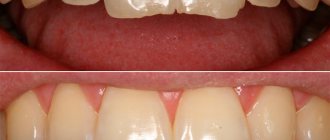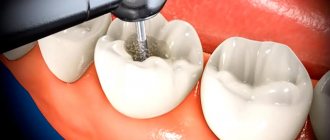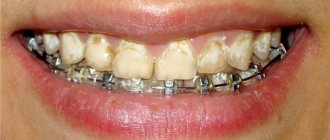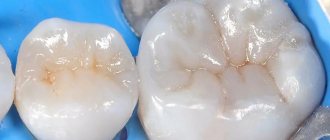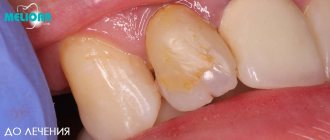10.01.2020
The quality of health today depends not only on financial capabilities, but also on a banal misunderstanding of the doctor’s wording. Some new-age medical terms confuse patients when they need to make a quick decision. Especially often a person hesitates in the dentist’s chair when the doctor offers to choose a filling. How significant is the difference between a light filling and a regular filling? Which one will last longer?
Conventional chemical
The main difference between a simple (chemical) filling and a light filling is how they harden. A regular filling becomes hard due to a chemical reaction that occurs when different types of filling material are mixed. The result is a consistency with the required density and elasticity.
Dentists typically use two types of conventional chemical fillings:
- Composite - it contains several different chemical ingredients, which, when hardened, can differ significantly from the natural color of tooth enamel. The material hardens evenly, but does not last long - usually about 2 years.
- Glass ionomer - contains a special liquid and powder, which are mixed in the required proportion.
The composition hardens due to an acid reaction. Dentists can add additional components to this mixture as needed. Attention! Glass ionomer filling is good because it has the ability to release fluoride, which serves as a preventive measure against the re-development of caries.
Why do you need to fill teeth?
The main task that fillings solve is to prevent the development of carious tooth decay. After high-quality cleaning of the damaged cavity and filling it with a filling, the risk of secondary caries will decrease to almost zero. This allows a person to lead a normal lifestyle and not experience any discomfort. In addition, fillings allow you to restore the aesthetics of your teeth.
Fillings are also used in case of tooth damage due to mechanical stress. This could be a chip from an impact or abrasion of a large layer of enamel.
Light
In the professional language of dentists, there are several variations of names for this filling: light, light-composite, gel filling. These terms have a direct connection with the method of curing the filling material. The light seal hardens when exposed to ultraviolet radiation from a special lamp. The hardened material looks natural and aesthetically pleasing. It fits tightly to the edges of the teeth and guarantees long service life.
The difference between light and conventional fillings also lies in the speed at which the material hardens. The components of the light filling polymerize under ultraviolet radiation and harden much faster than the ingredients of the chemical composition. It is very important for a dentist to do everything in 40 seconds. Otherwise, the filling material will begin to crack, since during the hardening process the dental canals are subjected to enormous stress from the inside. Dentists try to avoid this complication. To reduce the risk of cracks, filling material is applied to the canals in stages, in layers.
Attention! The main advantage of a light-curing filling is the ability to restore broken and completely destroyed teeth. The dentist can restore the natural shape of the tooth, its relief, and select the desired shade for full compatibility with the natural color of the enamel.
The light filling literally returns to the patient what seemed hopelessly lost - a realistic tooth and a smile without complexes. But there is also a minus. If the carious cavity is very deep, the dentist will not be able to perform light polymerization and will place a conventional chemical filling in the tooth.
Plastic, metal and ceramic compounds
Plastic fillings are also at the peak of popularity, also due to their low price. Plastic has many disadvantages:
- gives significant shrinkage after curing;
- changes its color over time;
- quickly wears out and becomes unusable;
- poorly protects against secondary caries.
Important! Cement and plastic fillings are placed in free dental clinics.
Ceramic compositions
The distinctive characteristics of this material are high strength, lack of shrinkage and aesthetics. Ceramics does not darken during use and is not painted. In modern dentistry, ceramics is considered an almost ideal filling material. Types of ceramics include:
- transparent material;
- pressed material;
- metal ceramics.
The disadvantages include the difficulty of installation: the composition fills the hole in the tooth, like an inlay. The inlay is formed using an impression of a previously sanitized tooth.
Metal alloys
Amalgam material includes a mercury compound along with silver. The dangers of exposure to mercury in the body pose a certain health risk. The advantage of amalgam is its long service life and abrasion resistance.
Another disadvantage of this material is expansion during hardening. If the dentist does not correctly calculate the volume of the filling, the possibility of slight destruction of the crown cannot be ruled out.
Due to the unaesthetic appearance of metal structures, they are used on back teeth or the hidden surface of the crown.
How much does a light seal cost?
Prices for dental work in reliable clinics are based on how complicated (or neglected) the tooth is. The cost of a light filling also depends on the condition of the tooth - the depth of the carious cavity, the degree of destruction of the walls, and the health of the canals. The more work the dentist requires, the higher the price will be. But the financial side of the issue may depend not only on the illness that the patient brought with him. If the clinic has a high status and brilliant authority, the price for a light filling may be too high. This is how reputable clinics maintain their status. Conversely, if a dental office has opened recently, and its main task is to attract customers, the price tags for services may be low.
In general, the cost of a light-curing filling ranges from 2,000 to 15,000 rubles. But higher prices are also possible (as a rule, in cases where the tooth is too neglected). Filling the front teeth is always more expensive than the back teeth, because the smile area requires the highest quality and most expensive materials. The variety of dental clinics today is too great to not know where to go. Each patient decides for himself what to choose: either too expensive treatment, but with a guarantee of quality, or hope for a successful result and significant savings. There is a third option: price and quality in equal proportions - you need to choose this one. As a rule, many patients rely on reviews from friends and acquaintances, and on this basis they choose a clinic and a dentist. The most important thing is not to forget that a healthy smile is priceless.
Classification of filling materials
Fillings can be temporary or permanent.
A temporary filling serves to temporarily isolate a dental cavity with a medicinal drug introduced into it, and sometimes it itself contains this drug. Sometimes a temporary filling is applied because the doctor is not ready to completely rule out the development of pulpitis.
Temporary and permanent fillings differ in composition. To make temporary fillings, materials of less strength are used, this gives the doctor the opportunity to easily remove the filling during the next visit to the patient. Most often, such fillings are made from artificial dentin mixed with water.
Permanent fillings , if made from high-quality materials and installed in compliance with all requirements, can last for many years and even decades.
Benefits of light filling
Light polymerization fillings are more modern, which means they are created using improved technology, which distinguishes this material from chemical ones. What are the advantages of a light filling over a regular one?
- High plasticity. The dentist can safely form the crown of the tooth without fear that the material will harden ahead of time and something will be left unfinished. The light composition hardens only under targeted exposure to an ultraviolet lamp.
- Softness of the material. The special structure of the composition allows you to qualitatively fill all the anatomical convolutions in the tooth cavity and adhere tightly to the edges. Fits perfectly on any teeth: front and back.
- Hypoallergenic, non-toxic composition. This filling can be placed during pregnancy and the lactation period - it is completely harmless to the body.
- Wide range of shades. The dentist can choose the natural color of the enamel for any patient, and this is very important when filling the front teeth.
- Compliance of the material. It is easy and quick to sand and polish.
- Rapid maturation of the material. After installing the light-curing composite, the patient can eat food almost immediately without fear of escaping.
- Less painful tooth preparation. The patient will not suffer much from contact with the drill.
- Wear resistance. A light seal can serve a person for more than 5 years.
When treating a chewing tooth that is not too neglected, the patient, as a rule, can save on filling material and choose a chemical one. But when it comes to the smile itself, then you simply cannot do without the use of a light filling with its significant advantages.
Category Dental filling Posted by Mister stomatolog
Composite compounds
Chemically cured composites were invented as an alternative to simple cement fillings. The composition of the composite includes porcelain, which gives greater strength to the cement. Also, according to their composition, composites are divided into three types:
- acrylic-containing;
- resin (epoxy);
- light-curing.
Of the listed compositions, the acrylic-containing composite has the greatest strength. These fillings are characterized by wear resistance, are little susceptible to abrasion, however, they have a toxic effect on the body. Due to toxicity, acrylic is contraindicated in many patients. Acrylic also often provokes the formation of pulpitis. Another negative feature of acrylic is its high absorbency, due to which the risk of caries increases significantly.
Resin composite material is not highly wear-resistant and durable, however, it is non-toxic and harmless to the body. The disadvantages of resin structures include a change in color after a few years: the fillings darken. Another feature of resin (epoxy) fillings is their excessive fragility: they can break off and be “eaten.” Therefore, it is better not to use epoxy composition on primary chewing molars. Epoxy composite also provokes the development of pulpitis, just like acrylic.
The light-curing composite gains its strength from a halogen lamp. They are also called photopolymer or solar-cured. The disadvantage of this material is the complexity of installation: polishing and grinding of the material is necessary. The filling must be polished every six months to maintain the original tone of the material.
What other disadvantages are typical for this material? These include the following properties of the filling:
- shrinkage after curing;
- possible chipping of the crown wall;
- poor-quality hardening of the material.
The filling can shrink up to five percent of its original volume, which significantly reduces the effectiveness of protecting the tooth. Even with slight shrinkage of the filling, there is a high probability of chipping of the adjacent wall of the dental crown. Due to the technical difficulties of working with a halogen lamp, the hardening of the material may be incomplete - only 70%.
An innovation in modern dentistry is a nanocomposite, the structure of which consists of tiny particles. The nanocomposite is characterized by high adhesion to tooth tissues, providing reliable protection against infection and the spread of caries.
What anesthesia is used?
Anesthesia is not necessary during tooth filling. If the lesions are small, the filling procedure can be performed without pain relief. Often it does not cause any discomfort to the patient and is carried out quite quickly.
In cases where the lesion has many lesions or is very deep, the patient may be given local anesthesia. To do this, one or more injections are made into the gum near the diseased tooth.
In some cases, general anesthesia may be used. However, it is used extremely rarely. Usually it is resorted to when it is necessary to carry out treatment in young children or patients who are terrified of such interventions.
Contraindications for filling
There are very few contraindications to filling. Usually they are limited to recommendations for the use of a specific type of filling, since they may be allergic to others.
Other contraindications include the following:
- subgingival destruction, which limits access to the damaged area and also makes it impossible to isolate this area from saliva;
- the presence of bruxism in the patient, which is accompanied by frequent grinding of teeth for no reason, as a result of which fresh fillings are quickly destroyed;
- increased tooth abrasion, which will also quickly render the filling unusable.
In addition, filling is not carried out when more than 1/3 of the tooth is damaged by caries. In this case, the doctor may recommend its removal with further use of the implant. Another solution may be to use a crown, which is placed on a completely cleaned tooth.

